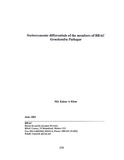Socioeconomic differentials of the members of BRAC Gonokendra Patltagar
Date
2002-06Publisher
Research and Evaluation Division, BracAuthor
Khan, Md. Kaisar AMetadata
Show full item recordCitation
Khan, M. K. A. (2002). Socioeconomic differentials of the members of BRAC Gonokendra Patltagar. Research Reports (2002), Social Studies, (XXIX), 230–267.Abstract
This study aimed to document the socioeconomic background of the members of BRAC
Gonokendra (community-based library). to identify why some members did not avail its
services and why some members of the Management Committee did not play an active
role in managing the pathagars. A total of 904 members were selected through
systematic random sampling. Besides, 74 general users and 26 members of the
Management Committee were selected purposively. The study revealed that the
programme successfully mobilised the literate rural people of all age groups as well as all
economic strata. More male members attended than female members, but female
members borrowed more books than male members. Children and students of lower
grades were more regular in attendance and borrowed more books than members of
higher age groups and the students of higher grades. Amongst the non-student members,
the higher educated were more regular in attendance than the lower educated, and
borrowed more books. Lack of interest of the members towards pathagars, lack of
reading habit, students' tum over from the associated schools or colleges, lack of new
arrivals of reading materials, and pressure of academic study seemed to be the major
reasons for not availing the services of the pathagars. On the other hand, members of the
Management Committee did not play an active role due to dependency on BRAC staff,
lack of practice of power, and involvement in occupational activities. It was realised that
there still have rooms to extend its services among the target population. Thus, extensive
campaigns are needed to motivate the members as well as the community to maximize
the use of pathagars. At the same time, a participatory management system may be
applied to ensure more close community involvement in managing the pathagars.

